Exotic Tone Woods For Guitars
We Have Spectacular Quality Inventory of Exotic Woods
Ten Piece Minimum. Please Don't Ask to Buy One Piece. Ed Roman Has the Largest Selection of Exotic Tone Woods In The World
Exotic Woods
- Alaskan Sitka Spruce
- Alder
- Amboina Burl
- Ash (Swamp)
- Bajoran Palisander
- Basswood
- Bloodwood
- Bocote
- Bubinga
- Buckeye Burl
- Che Chin
- Cherry
- Cocobolo
- Cohagerie
- Ebony, Gaboon
- Ebony, Macassar
- Elm, Carpathian Burl
- Goncalva Alves
- Koa (Hawaiian)
- Kokarado (Laotian Stripe)
- Korina, Black (Limba)
- Lacewood, Silky Oak
- Madrone Quilted
- Mahogany, Honduras
- Maple Birdseye
- Maple Burl
- Maple, Flamed
- Maple, Spalted
Many exotic tone woods are subject to ultra small and microscopic cracks in the wood.
We cannot guarantee against this happening because we use so many varied species.
It is usually entirely unnecessary to repair anyway & almost invisible to the human eye.

This Guitar was Hand-Built in Ed Roman's Custom Shop, 2005
Quicksilver Custom Built For Mike Clifford In Las Vegas
Spectacular Quilted Maple Top
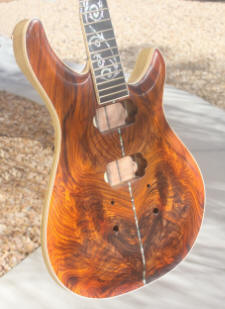
FLAMING COCOBOLO
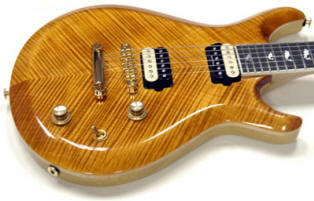
Flame Top Avanti Guitar
CHEVRON PATTERN
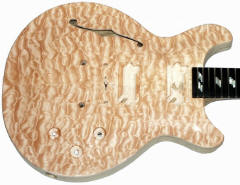
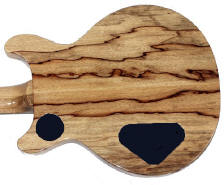
Blister Quilted Maple
Highly Figured Korina Back & Neck

Pearlcaster's & Magic Twanger's

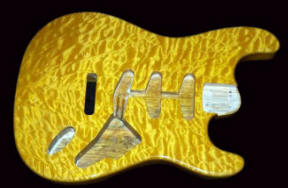
A Word About Ed Roman's Wood Prices
If
our wood prices seem high
there are some very important facts you need to know!!
Ed Roman's Prices Are Less Than Half
Of What
Alembic
Charges !!!!
The Quality of Ed's Roman's Wood Is
The
Absolute Best Quality In The World!!!!
What PRS Calls A 10 top Is Quite Nice,
But It Does Not
Compare To Ed Roman Medallion Grade !!!
No Expense Is Spared To Buy The Absolute
Finest Tonewoods That Can Be Found Anywhere!!!!
No Other Guitar Manufacturer Anywhere
In The World Offers As
Many Different Wood Choices!!!
|
In the past 20 years I have sold beautiful tone woods to many guitar manufacturers when they wanted something extremely nice for a special customer. I specialize in many different rare specimens. The wood list above will give you an idea as to what I have in stock. I generally have a selection of almost everything on the list. I am always looking for new and strange examples of different species. Recently I have been experimenting with Redwood & Giant Sequoia, I have found the wood both beautiful & extremely resonant sounding. I generally hand-pick every single piece of wood that I buy. I select each piece for tone and beauty and I spare no expense to buy the absolute finest wood I can find. I make several trips a year to the Pacific Northwest and I actually visit the sawmills. Sometimes I only buy one or two pieces in a day, and as you can imagine this drives the price up. If you get to see the woods I have stockpiled in my wood room though, you will be knocked out! Maple is a strong and extremely dense, heavy wood. It is excellent for guitar necks and bodies because it can handle an inordinate amount of string tension. Maple has a bright and crisp tone and is used on flamenco guitars as well as some electrics. It has a wide variety of exotic grains that show up quite well when finished. Flamed maple is a very popular and brilliant looking exotic type of maple. "Flamed" refers to the rippling, or curls of the grain of wood that run across the body. Flamed maple is generally "book matched," which means that the body is made of two half pieces of a single cut piece of maple. This gives the guitar even weight, look and tone throughout the body. |
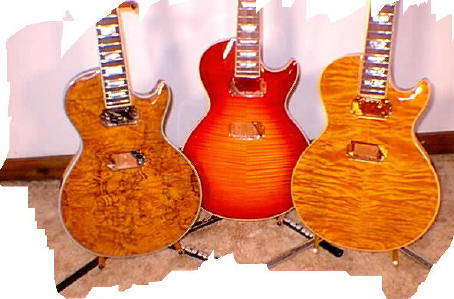
Gibson's Retopped in our shop
Left 5A Burley Maple ---
Middle 4A Flamed Maple ---
Right
4A Quilt/Flame Maple

Assorted Blank Fingerboards
I have Solid Brazilian Rosewood Neck Blanks for $400.00 just like PRS used on their $9,000.00 Rosewood Ltd. Model (I buy them from the same supplier that PRS buys from) I also have solid Ebony & African Rosewood necks available.
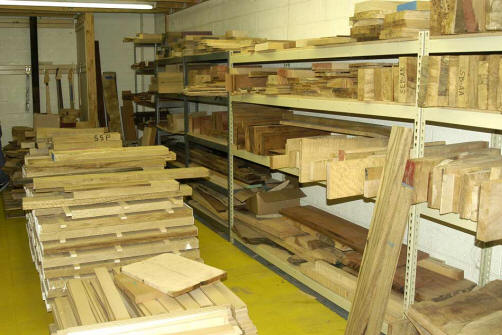
If you would like to make an appointment to get together
to pick out a special piece of wood for an electric guitar
please call me.
Ed Roman
(702) 597-0147
Click Here for Worlds Best Guitars
|
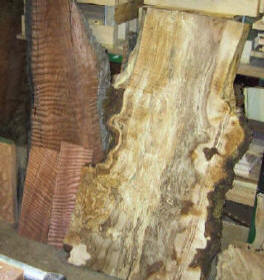
Pearlcaster Area In Our Shop
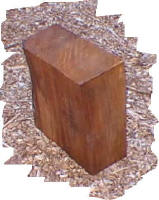
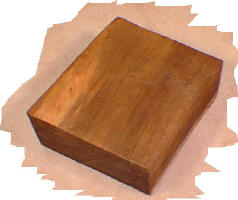

Raw Chunk of Koa Wood
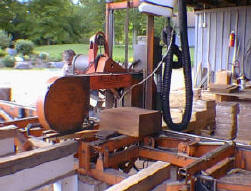
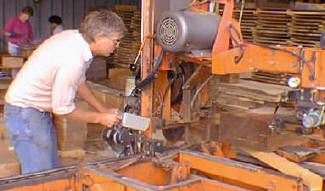
|
Standard Woods In Use By Most Companies
Mahogany We don't use to much mahogany at Ed Roman's simply because we are known as an exotic builder. People generally expect something a little more exotic from us. Koa Wood Alder Solid Alder Spruce Solid Spruce
Canadian Sitka Spruce
German Spruce Maple Cedar Brazilian Rosewood East Indian Rosewood Nato |
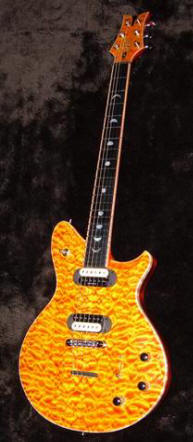
JET Guitars
are not cheap they
usually run
from $4,500.00 to $9,000.00
But They Are Worth Every
Penny
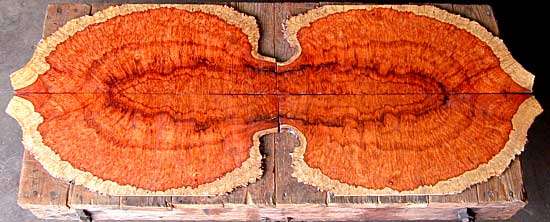
A piece of wood like above can cost well over $4,000.00
|
Computer Numerically Controlled
All of the delicate cutting operations are done by $85,000.00 machine. All of the shaping, sanding, binding & fitting is robotically accomplished. There are no human hands, no human eyes to line up the wood perfectly so that imperfections in the wood fall into locations that won't be seen later. There is nothing illegal about building a guitar with a machine. I feel, it's totally unethical and immoral to charge the extremely high hand made prices. just because you made your original reputation by building handmade guitars. Most every large company is guilty of this, I can think of very few large companies who still actually handbuild their guitars. BC Rich USA, Jackson Custom Shop, & maybe the PRS private stock guitars are semi hand built. These are all I can think of, off the top of my head. I repeat, There is nothing wrong with CNC made guitars except that they are usually overpriced and under built. They generally lack a certain vibe, soul or character that can only be achieved from a hand built guitar. Not everyone can necessarily benefit from these detailed characteristics, So that's why a custom made hand built guitar isn't for everyone. I always recommend a mid priced machine made Fender, Jackson, Dean, OLP, Hamer, or Ibanez for a beginner or for the working musician who needs a good low cost guitar. A custom made guitar is not for everyone. When and if, you finally decide to get a custom made instrument, you cross the threshold between good & great. Today a machine made guitar is considered a tool and a handmade one is potentially an heirloom or an investment guitar. The worst offenders that I can think of is ESP, Lakland, Gibson & Taylor. Many people assume that these companies are hand building. The ESP guitars are totally machine made in Asia and priced incredibly high. The Lakland guitars offer a USA made and an Asian made model, Both are so unbelievably overpriced that It should be a crime. Gibson guitars are well known for being overpriced by everyone, I feel that their machine made guitars are overpriced so much that even if they were handmade they are still incredibly overpriced. In the case of Taylor, they are also machine made and if you pay attention to their ridiculous image based advertising campaign you might think they were handmade. NOT!!!!!! PRS on the other hand has publicly stated that they are %100 machine made. (Kudos For Honesty) Up until a couple of years ago they actually used to be proud of it, They even boasted about it. Today the consumer isn't as stupid as they used to be, thanks to people who print these little expos�'s on their websites. Today PRS doesn't call too much attention to it and in their last catalog they show numerous photos of craftsmen actually carving guitars. I presume those guitars are their private stock models, I know they are not the models you will see when you walk into a big box store or corporate superstore. Tom Anderson says he builds three guitars a day, that may be %100 true. Or is this just a clever way to possibly make the consumer think they are handmade. Because Tom has CNC machinery and if he wanted to he could produce many more guitars a day. This whole article was prompted by a customer who attempted to trade in a plain black blah looking Sadowsky NYC Bass earlier today. I offered the customer what I considered to be a very generous trade in, I actually offered him way too much by my standard, $2,000.00 because I had heard that these basses were pretty good. When he told me he wanted $3,500.00 for the bass I was appalled. This instrument is made from parts & constructed almost exactly like a Fender. The customer went on to tell me that the electronics were amazing. I played the bass, I had to agree the electronics were great. However I know that once an electronic circuit is designed you can copy it exactly for less than $10.00 each. I also like the way the bass played & felt. I just could not wrap myself around the price. I did about 15 minutes of research and I was able to determine who builds the bodies, necks, bridge, tuners & pickups. My own production made machine made low end "Lowrider" model bass can be bought brand new for about $2,700.00 cheaper. Coincidentally the components are all exactly the same. (With exception of his proprietary electronic circuit) Now I'm not claiming my bass is better, I'm not claiming anything. I'm just trying to make a point about overpricing... (You No Longer Get What You Pay For !!! & That's A Cold Hard Fact) We have in our inventory at least 2 Fender Basses with Sadowsky's $250.00 electronics built in should we charge $250.00 more or should we charge $2,500.00 more (Think about it) Ed Roman |
|
More Deprogramming From Ed
Roman There Are 2 Major Clich�'s That Are No Longer True In The Guitar Business 1. You Get What You Pay For!!!! It's painfully obvious to me or to anyone who is not intellectually challenged that today many large corporations use this tired old clich� to their financial advantage. They are constantly pricing guitars at extremely high prices, so that consumers will think they are actually handmade well built instruments. I first learned this fact back in 1991, I was employed by Gibson Guitars. The president of Gibson, Henry Juszkiewicz made this statement to me. "The higher the price the better the guitar" "or at least that will be the customers perception". This may have backfired a little on him, due to the fact that this artificial perception, that a production made guitar has to be so expensive, has made it possible for custom builders like, Myself, JET, Gledura, Jaros, Benedetto, McPherson, Dingwall, & Alembic to flourish. Simply because most intelligent people, would rather have a custom guitar. Especially if they could buy it for the same price or less than a machine made production instrument. 2. It's Just Too Good To Be True!!!! That's another Bulls&%t Clich�, The Man & all the large corporations want to instill in your mind. (Don't you believe that for even one second !!!!!!!!) A tribe isn't a tribe unless it has one Chief &
many Indians. The question you must ask yourself your whole life is "Am I A Chief, Or Am I An Indian" The Indian will believe the old "It's too good to be true" adage and go back to smoking his peace pipe. The Chief will just go for it. There lies the inherent difference. Some people play original music, They are known as innovators, Some people play only cover tunes, In Vegas they are known as Lounge Bands. Now that doesn't make these people bad people,
But it doesn't make them Chief's either !!!! Ed Roman Monkey See Monkey Do |
Many exotic tone woods are subject to ultra small & microscopic cracks in the wood.
We cannot guarantee against this happening because we use so many varied species
It is usually entirely unnecessary to repair anyway & almost invisible to the human eye.

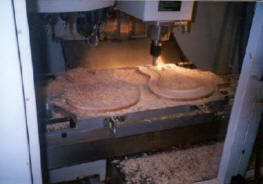
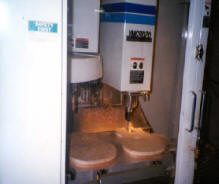 You are looking at a
CNC machine
You are looking at a
CNC machine